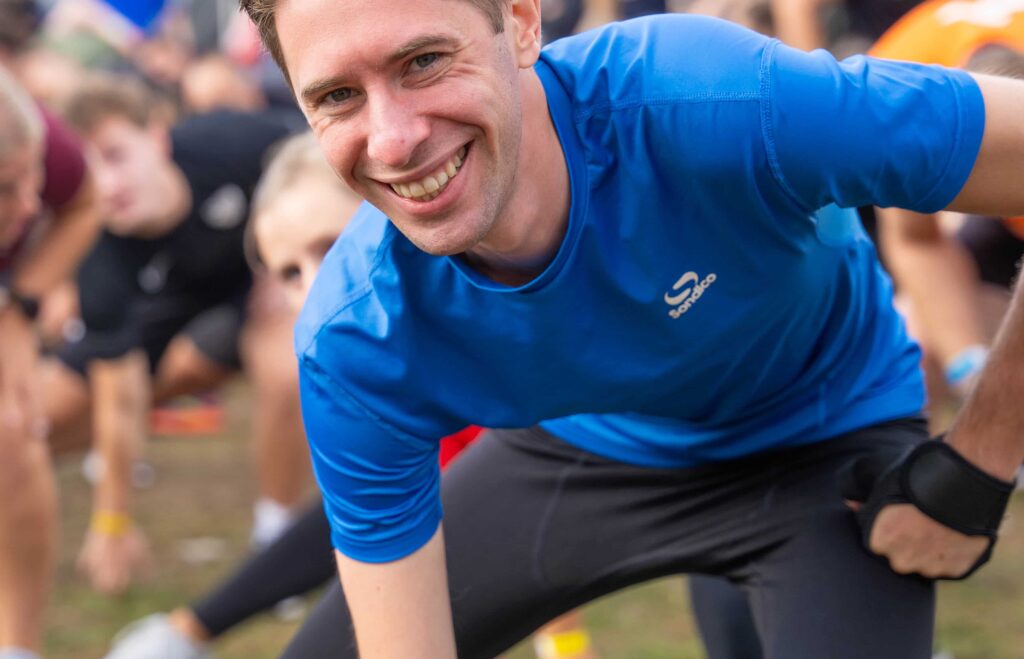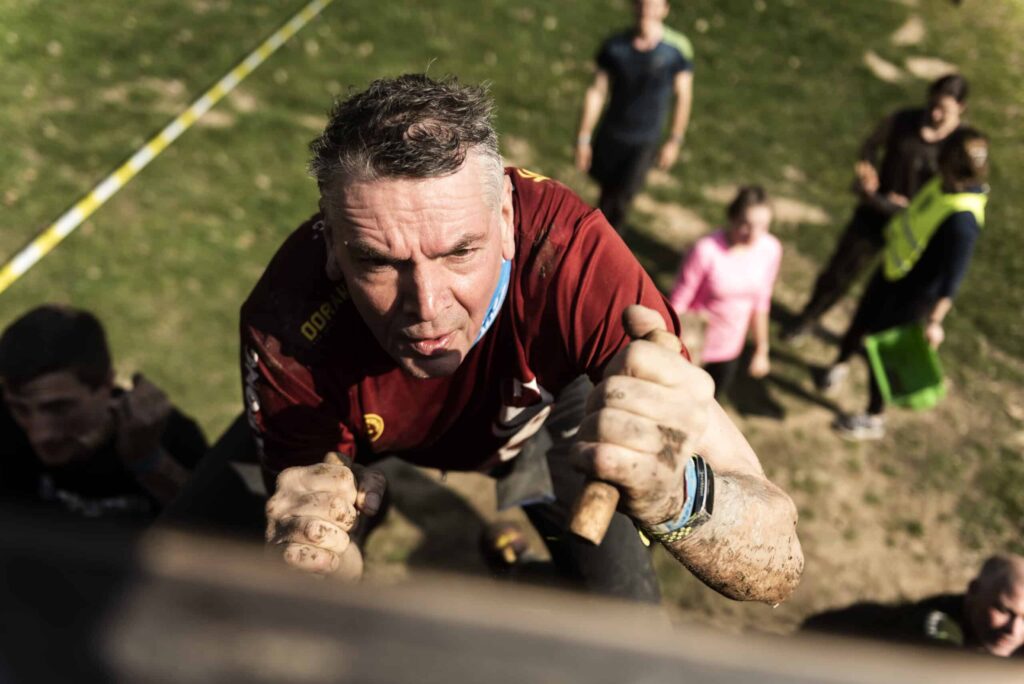Table of Contents
What is functional training?
Functional training is a workout method that focuses on exercises to help you move better in everyday life. Instead of training isolated muscle groups, functional training emphasizes movements that use multiple muscles and joints simultaneously. These are the movements you perform daily, such as lifting, bending, jumping, and twisting. These exercises not only improve your strength but also your stability, coordination, and endurance. The goal is to make your body perform better during daily activities and athletic challenges like an obstacle run.
Traditional strength training vs functional training
Many people are familiar with strength training: lifting weights and working on machines at the gym. Functional training, however, differs from traditional strength training. Below, we explain the key differences between strength training and functional strength training.
Strength training focuses on building muscle strength and mass by lifting heavy weights and doing isolation exercises. You primarily work on specific muscles and often use machines or free weights.
Functional training helps you with everyday movements by doing exercises that engage multiple muscle groups at once. It’s about exercises that improve your balance, coordination, and overall strength, like lunges and burpees. Functional strength training can be a great complement to traditional strength training.

The benefits of functional training
As explained earlier, functional training not only makes you fitter but also more functional in daily life. But what other benefits does functional training bring? Below we discuss some key benefits:
1. Improved strength
With functional strength training you train exercises that use multiple muscles simultaneously. This makes your body stronger, which is helpful for daily tasks and sports.
2. Increased endurance
Regular functional training improves your stamina. You can work or exercise longer and harder without getting tired quickly.
3. Injury prevention
By training movements you use daily, you reduce the risk of injuries. Your body becomes better prepared for physical demands, helping you avoid severe muscle pain and injuries.
4. Better balance and coordination
Functional training helps improve your balance and coordination. You learn to use different muscles simultaneously, increasing your control and stability.
5. More efficient workouts
Instead of training only specific muscles, functional training works on multiple muscles at once. This makes your workout more efficient and promotes better muscle balance.
6. Practical application
The exercises are based on daily movements like lifting and bending, preparing you better for everyday activities.
7. Helps prepare for obstacle runs
If you’re preparing for an obstacle run, functional training is very useful. The exercises strengthen your grip, endurance, and strength, helping you overcome obstacles and improve your performance.
Functional training workout: 10 exercises
Great! You’re ready to start functional fitness! Did you know you can even do this at home? Of course, you can go to the gym, but there are plenty of functional strength training exercises you can do at home, both with and without equipment.
Exercises without equipment
1. Squats
Stand with your feet shoulder-width apart. Bend your knees as if you are sitting on a chair, keeping your back straight and your knees in line with your feet. Stand back up and repeat!
Muscles: Quadriceps, hamstrings, glutes, adductors, abs, and lower back muscles
Daily benefit: Helps with standing up from a chair or lifting objects from the ground.
2. Push-ups
Lie flat on your stomach with your hands slightly wider than shoulder-width apart. Push yourself up by extending your arms, lower your body until your chest nearly touches the floor, and push back up.
Muscles: Chest, shoulders, triceps, abs, and lower back muscles
Daily benefit: Strengthens your chest and arm muscles, useful for pushing and lifting.
3. Lunges
Step one foot forward and lower your knees until your back knee nearly touches the floor. Make sure your front knee doesn’t go past your toes. Stand back up and switch legs.
Muscles: Quadriceps, hamstrings, glutes, adductors, and core muscles
Daily benefit: Improves your stability and strength when climbing stairs or bending down to pick something up.
4. Burpees
Start in a standing position. Drop into a squat, place your hands on the floor, and jump your feet back into a push-up position. Perform a push-up, jump your feet back to your hands, and jump straight up.
Muscles: Chest, shoulders, triceps, abs, hamstrings, glutes, and calves
Daily benefit: Improves your endurance and strength, which helps with energetic and demanding tasks like lifting heavy objects or moving quickly.
5. Straight-Leg Sit-Up
Lie on your back with your legs straight and your arms by your side or behind your head. Lift your head, shoulders, and upper back off the ground as you engage your abs. Keep your feet on the ground and slowly lower yourself back to the starting position.
Muscles: Abs, hip flexors
Daily benefit: Strengthens your abs, helping improve your overall core strength and supporting your back during activities like lifting and bending.
Exercises with equipment
6. Kettlebell Swings
Stand with your feet shoulder-width apart. Hold a kettlebell with both hands and swing it between your legs, then upward to shoulder height by powerfully thrusting your hips forward.
Muscles: Glutes, hamstrings, lower back, core muscles, shoulders, and grip muscles
Daily benefit: Strengthens your hips, back, and grip, useful for lifting and carrying heavy objects.
7. Dumbbell Rows
Support one hand and knee on a bench, holding a dumbbell in the other hand. Pull the dumbbell towards your side by bending your elbow and squeezing your shoulder blade.
Muscles: Back muscles (such as the latissimus dorsi), biceps, shoulders, and core muscles
Daily benefit: Strengthens your back muscles, helping with pulling objects or opening heavy doors.
8. Resistance Band Squats
Stand with your feet on a resistance band and hold the band at your shoulders. Perform a squat while keeping the band under tension.
Muscles: Quadriceps, hamstrings, glutes, adductors, and core muscles
Daily benefit: Strengthens your legs and core, helpful for lifting and bending.
9. Farmer’s Walk
Hold a pair of dumbbells or kettlebells and walk upright with the weights by your sides. Make sure to keep a firm grip and maintain a straight back while walking.
Muscles: Grip muscles, forearms, shoulders, back muscles, and core muscles
Daily benefit: Strengthens your grip strength and forearms, useful for carrying heavy bags or lifting objects.
10. Box Step-Up
Use a sturdy elevated surface like a bench or a step. Step one foot onto the surface and push yourself up until you’re standing with both feet on the surface. Step back down and repeat with the other foot.
Muscles: Quadriceps, hamstrings, glutes, calves, and core muscles
Daily benefit: Strengthens your legs and improves your balance and coordination, helpful for climbing stairs or stepping in and out of vehicles.

Functional training for an obstacle run
Obstacle runs require strength, endurance, and a good dose of perseverance. Fortunately, functional training is perfect for helping you out. With exercises like kettlebell swings, burpees, and box jumps, you can improve your explosive strength and stamina. As a result, you’ll feel stronger and fitter during the run!
Functional training also helps you become not just stronger but also better balanced and more coordinated. This is crucial for overcoming the challenging obstacles you’ll face. In the obstacle run training plans, you’ll find functional training exercises that will help you easily reach that finish line. Oorah!
Don’t have a ticket for your next obstacle run? Get your Strong Viking ticket now via the button below!